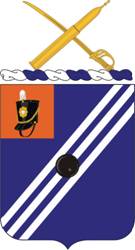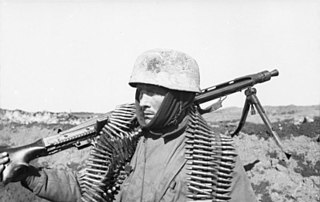Related Research Articles

Airborne forces are ground combat units carried by aircraft and airdropped into battle zones, typically by parachute drop or air assault. Parachute-qualified infantry soldiers serving in airborne force are also known as paratroopers.

A commando is a combatant, or operative of an elite light infantry or special operations force using dedicated operation techniques.

The 36th Infantry Division ("Arrowhead"), also known as the "Panther Division", "Lone Star Division", "The Texas Army", or the "T-patchers", is an infantry division of the United States Army and part of the Texas Army National Guard. It was organized during World War I from units of the Texas and Oklahoma National Guard. As an all-Texas unit, it was called for service for World War II 25 November 1940, was sent to the European Theater of Operations in April 1943, and returned to the Texas Army National Guard in December 1945.

The 6th SS Mountain Division "Nord" was a German unit of the Waffen-SS during World War II, formed in February 1941 as SS Kampfgruppe Nord.

The 91st Infantry Division is an infantry division of the United States Army that fought in World War I and World War II. From 1946 until 2008, it was part of the United States Army Reserve. It was briefly inactivated from 2008 until 2010 when it was elevated back to a division size element as the 91st Training Division (Operations).

The 78th Training Division (Operations) ("Lightning") is a unit of the United States Army which served in World War I and World War II as the 78th Infantry Division, and currently trains and evaluates units of the United States Army Reserve for deployment.

The 84th Training Command ("Railsplitters") is a formation of the United States Army. During World War I it was designated the 84th Division, American Expeditionary Forces; during World War II it was known as the 84th Infantry Division. From 1946 to 1952, the division was a part of the United States Army Reserve as the 84th Airborne Division. In 1959, the division was reorganized and redesignated once more as the 84th Division. The division was headquartered in Milwaukee in command of over 4,100 soldiers divided into eight brigades—including an ROTC brigade—spread throughout seven states.

The 8th Infantry Division, ("Pathfinder") was an infantry division of the United States Army during the 20th century. The division served in World War I, World War II, and Operation Desert Storm. Initially activated in January 1918, the unit did not see combat during World War I and returned to the United States. Activated again on 1 July 1940 as part of the build-up of military forces prior to the United States' entry into World War II, the division saw extensive action in the European Theatre of Operations. Following World War II, the division was moved to West Germany, where it remained stationed at the Rose Barracks in Bad Kreuznach until it was inactivated on 17 January 1992.

The 334th Infantry Division was a German Army infantry division in World War II. Originally formed in November 1942, it surrendered to the Allies at the conclusion of the Tunisian Campaign in May 1943. The division was reconstituted on 3 June 1943 in France within the 1st Army, with the staff of the 80th Infantry Division as well as remnants of the old division and replacement units. It spent the remainder of the war serving on the Italian Front.

The 163rd Infantry Division was a German Army infantry division in World War II. Formed in November 1939, it was engaged in the invasion of Norway the following year. It fought alongside the Finnish Army during Operation Barbarossa against the Soviet Union. During this time, the division's transit through neutral Sweden caused the Midsummer Crisis of 1941. The division spent most of the war in Finland, before being returned to Germany. It was destroyed in March 1945 in Pomerania by the First Polish Army, subordinated to the Soviet 1st Belorussian Front.
The 1st Mountain Division was an elite formation of the German Wehrmacht during World War II, and is remembered for its involvement in multiple large-scale war crimes. It was created on 9 April 1938 in Garmisch Partenkirchen from the Mountain Brigade which was itself formed on 1 June 1935. The division consisted mainly of Bavarians and some Austrians.

The 509th Infantry Regiment is an airborne infantry regiment of the United States Army. The unit was initially activated as a single battalion, the 504th Parachute Infantry Battalion, in October 1941 at Fort Benning, Georgia. Nicknamed "Geronimo", the 509th conducted the U.S. Army's first combat jump during World War II on 8 November 1942, flying 1,500 miles from England to seize Tafarquay airport in Oran, Algeria. The 509th made a total of five combat jumps during the war.

The 76th Infantry Division was an infantry division of the British Army, which was formed in November 1941 and served during the Second World War. It was created when the Norfolk County Division, initially raised in 1940 to defend the Norfolk coast from a potential German invasion, was redesignated. The division maintained the defensive duties that had been assigned to it, prior to it being renamed, until late 1942 when it became a training formation. It was then responsible for providing final tactical and field training to soldiers who had already passed their initial training. After five additional weeks of training, the soldiers were posted to fighting formations overseas. The formation was used as a source of reinforcements for the 21st Army Group, that was fighting in the Normandy campaign. After all available British troops had left the United Kingdom for France, the division was disbanded in September 1944.
The 159th Infantry Brigade was an infantry brigade of the British Army. Part of the Territorial Army (TA), the brigade was assigned to the 53rd (Welsh) Infantry Division and served with the division in the early stages of the Second World War until May 1942 when it was transferred to be the motorised infantry element of the 11th Armoured Division. The brigade would serve with the 11th Armoured in North-west Europe from June 1944 to May 1945.

The 31st Infantry Division was a German infantry division of the Army during World War II. It participated in the invasion of Poland in 1939 then the invasion of France and the Low Countries in 1940. As part of Panzergruppe 2. of Army Group Centre, it was involved in the invasion of the Soviet Union in June 1941. After hard fighting throughout 1941 and 1942 it joined the 9th Army and fought in the Battle of Kursk in July and August 1943. Along with the rest of the 9th Army, the division conducted a fighting withdrawal for the remainder of 1943, during which it sustained heavy casualties. In the early stages of the Soviet Operation Bagration of June to August 1944, the 31st Infantry Division was destroyed, a fate which subsequently befell most of Army Group Centre. The division was officially disbanded on 18 July 1944.

The 76th Field Artillery Regiment is a field artillery regiment of the United States Army. First formed as a cavalry regiment in 1916, the regiment was converted to field artillery in 1917, and served in Europe during World War I with the 3rd Division and as a separate battalion during World War II, as well as in peacetime at Fort Knox, KY, and Fort Devens, MA. Since 1959, the regiment has been a parent regiment under the Combat Arms Regimental System and the U.S. Army Regimental System, with regimental elements serving with the 3rd Infantry Division in Germany and Operation Iraqi Freedom, with the 7th Infantry Division in Korea, and in the Army Reserve. No regimental elements are currently active.

The Fallschirmjäger were the paratroop branch of the German Luftwaffe before and during World War II. They were the first German paratroopers to be committed in large-scale airborne operations. Throughout World War II, the commander of the branch was Kurt Student.
The 74th Infantry Regiment was a regular infantry regiment of the United States Army. There have been two units given the title '74th Infantry Regiment'; the first was a World War I unit of the 12th Division, and the second was a World War II unit formed with US Army personnel and equipment of the inactivating US-Canadian 1st Special Service Force "Devil's Brigade". This unit was first designated as the 474th Infantry Regiment, later redesignated as the 74th Infantry Regiment.
The 42nd Rifle Division was a unit of the Red Army during the Great Patriotic War. The division, first formed in 1940, was nearly destroyed in the opening days of the Operation Barbarossa defending the Brest Fortress. Disbanded in late December 1941 and immediately reformed in the Volga Military District. The division then served on the front until disbanded at the end of the war.
References
- ↑ "99th Infantry Battalion (Separate)." 99th Infantry Battalion (Sep) – World War 2 Educational Foundation, 2013. Web.
- ↑ "99th Infantry Battalion (Separate)". www.99battalion.org. Retrieved 2022-04-23.
- ↑ Szymczak, Robert. "The Battalion That Never Was: Dr. Teofil Starzyński, the OSS, and the Polish American Special Service Unit Project, 1942". Archived from the original on 2011-10-03. Retrieved 2012-01-06.
- ↑ Bradsher, Greg (Spring 1999). "Nazi Gold: The Merkers Mine Treasure". Prologue Magazine. Vol. 31, no. 1. National Archives. Retrieved December 26, 2018.
- ↑ "99th Battalion book". 99th Infantry Battalion. Retrieved 2022-04-23.
{{cite web}}: CS1 maint: url-status (link) - ↑ "99th Battalion - The Long Way Home - BOOK". www.99battalion.org. Retrieved 2022-04-23.